The ASUS Republic of Gamers G751 Review: G-SYNC Comes To The Notebook Computer
by Brett Howse on July 29, 2015 8:30 AM ESTDisplay
ASUS turned to LG to supply the IPS panel for the G751. The resolution is a mere 1920x1080, which on a panel this large works out to just 127 pixels per inch. That is certainly a low number when you see devices shipping now with UHD panels. On a gaming laptop, it would have been nice to see a higher resolution panel, but it seems that large high resolution panels are hard to come by, and all of the large gaming notebooks seem to be stuck at 1080p. Meanwhile I'm not ready to rule out the role G-SYNC played in this, as ASUS may have needed to stick to a 1080p panel for better G-SYNC support, especially given the slightly increased refresh rate the laptop supports.
The ironic thing is that a laptop with a GTX 980M would actually be able to handle a higher resolution in gaming and still get good frame rates, but unfortunately this is the state of how things are. That being said, being able to run Windows scaling at 100% is an advantage for certain applications, and games can be one of those scenarios.
But this is a gaming system, and 1080p seems to be where it’s at, but ASUS has gone with a 75 Hz panel which is a nice step up from the typical 60 Hz displays. And of course, it’s hooked up with NVIDIA’s G-SYNC technology to keep the frame rates smooth even if they dip below 75 frames per second.
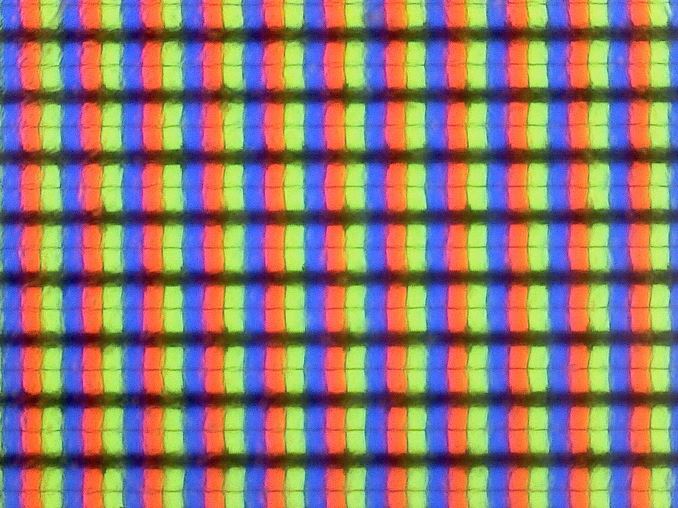
In order to test the display accuracy, we use SpectraCal’s CalMAN 5 suite with a custom workflow. Brightness and contrast readings are done with an X-Rite i1Display Pro colorimeter, and color accuracy is checked with an X-Rite i1Pro spectrophotometer. Like our battery life tests, the display is checked at 200 nits.
In the case of the ASUS, since it has several modes, I used the Splendid Normal mode which is the closest to the sRGB color space that is the calibration target.
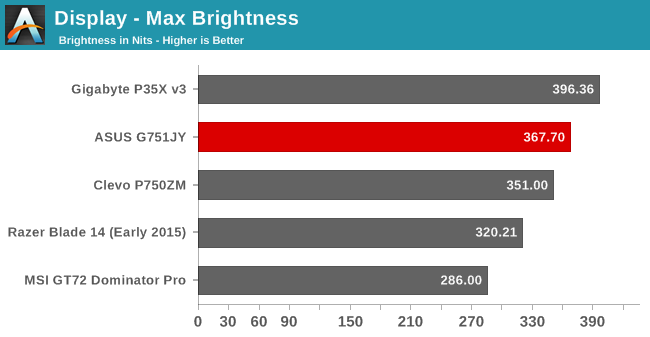
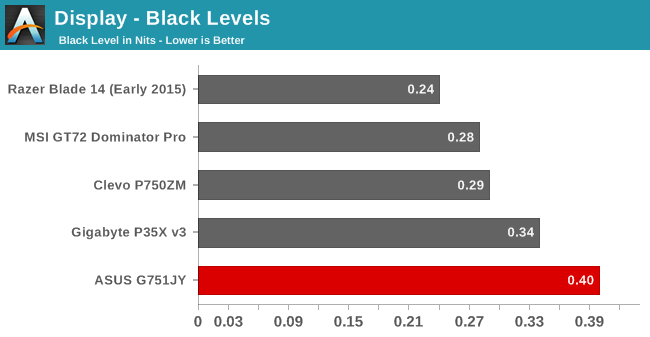
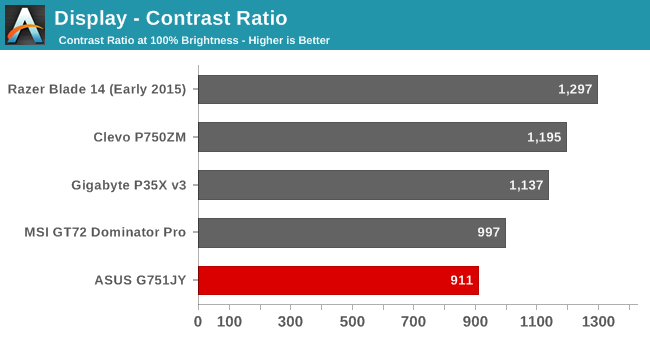
The G751 achieves almost 370 nits brightness, which should be plenty for any scenario where this matte panel is being used. The black levels are decent which results in a contrast ratio over just over 900:1. It’s a reasonable result, but still a ways off of the best panels out there. Still, it is a big step up on the TN panels that are still shipped on some gaming notebooks.
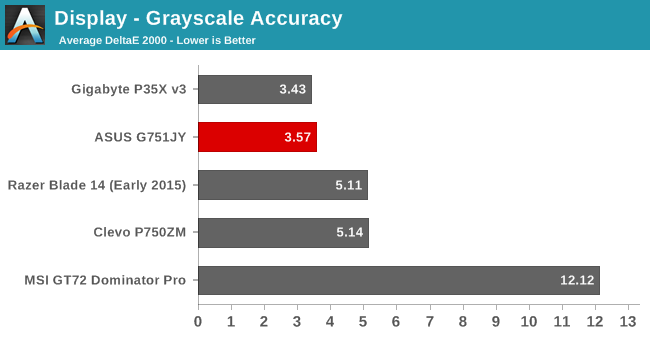
When looking at white levels, the red values creep up quite a bit which results in a display with a warm tone. The average grayscale is pretty good though, but the errors creep up as the brightness levels get higher. Gamma is pretty close to the 2.2 target using the Normal mode in the Splendid Color utility.
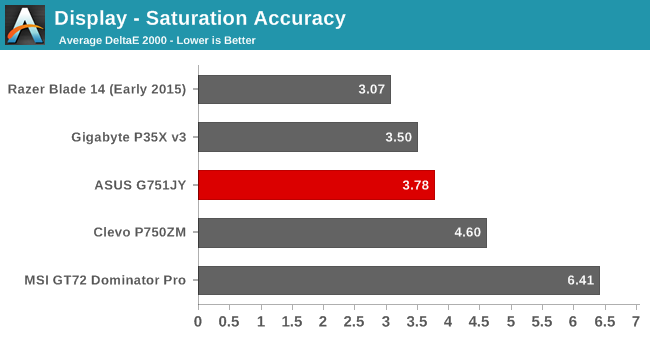
Once again we end up with a good result on saturations, but not quite perfect. According to CalMAN the panel can reproduce 88% of the sRGB color space. At 100% saturations, blue is a bit high which pulls magenta out as well.
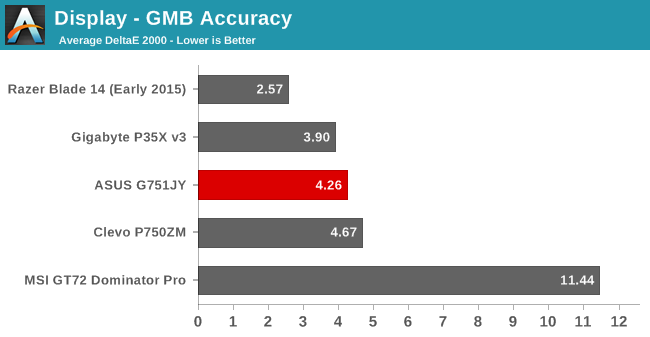
The Gretag MacBeth colorchecker is the most comprehensive test, and with all factors considered, the G751’s panel scores over four. For reference, values under three are considered not detectable, so the G751 is close but not quite there.
In order to give a look at what these errors in color accuracy represent, the above images represent a normalized view of the colors, with the correct color on the bottom and the displayed color on the top. Just remember that any inaccuracies in your own display will throw these results out, but they can be taken as a way to put a value to the inaccuracies.
The G751 has a great display for a gaming notebook, with an IPS panel that bumps the refresh rate up to 75 Hz, and the out of the box color accuracy is very good for a system like this. It could be better, but for most end users what is available is certainly good enough for gaming.


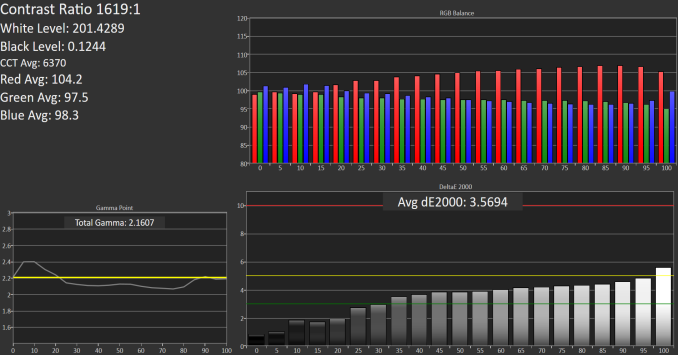
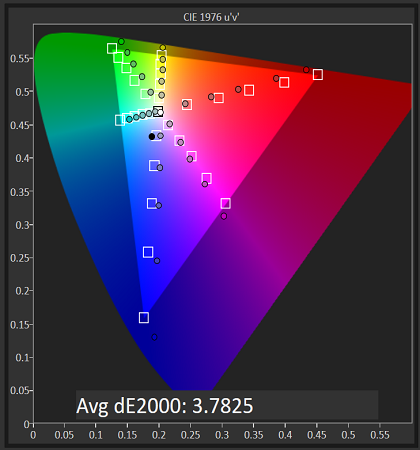
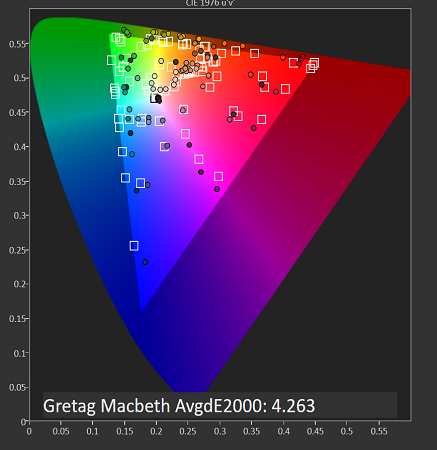










52 Comments
View All Comments
nathanddrews - Wednesday, July 29, 2015 - link
Does Intel plan on taking advantage of the Adaptive Sync tech anytime soon? I know they use it for other things for power saving (self-refresh, etc.), but it sure seems like a golden opportunity.In the same vein - given that we know (and have known for some time) that the G-Sync module is not required if you have eDP/DP1.2a, when can we expect a shift to tech-agnostic displays? Do we have to wait for DP1.3?
DanNeely - Wednesday, July 29, 2015 - link
I know eDP/DP1.2a provides a similar feature set to G-Sync; but has nVidia actually said anything about adopting it instead of (in addition to?) their current custom hardware implementation?DanNeely - Wednesday, July 29, 2015 - link
I suppose I deserve what I get for commenting before reading the 2nd page of the article; but as long as they're requiring additional qualification work to approve a panel for GSync, there's still plenty of potential to cause trouble for cross GPU support if they wanted to.nathanddrews - Wednesday, July 29, 2015 - link
VESA's Adaptive Sync is a part of eDP and DP 1.2a+. It's there, waiting to be used. G-Sync, FreeSync, and whatever Intel does are just the names for how they utilize it.The only reason NVIDIA pursued a custom module was because no desktop monitors - at the time - included A-Sync. Screens connected via eDP can. As we move forward with newer and newer displays, we're likely to see more and more of them be A-Sync-capable, which means being able to support any variable refresh technology, whatever the marketing label is. Whether or not those displays end up as G-Sync, FreeSync, or some sort of hybrid is up to the manufacturers, I suppose. Just like with G-Sync and FreeSync displays, optimizing the display will still be important.
Ideal situation: connect monitor to computer, GPU drivers load a default profile based upon EDID for frequency range and resolution support, advanced users can tweak (under/overclock/etc.), maybe share firmware, etc. to crowd-source calibration settings. Shipping a monitor back to a manufacturer for an update is ridiculous...
lefty2 - Thursday, July 30, 2015 - link
> The only reason NVIDIA pursued a custom module was because no desktop monitors - at the time - included A-Sync.This is not true. When AMD created FreeSync the DisplayPort 1.2a monitors did not exist either, but instead of creating a propierty solution, they got FreeSync incorperated into the open standard. Nvidia could have done the same thing, but they prefer using propierty standards to lock the customers in.
nathanddrews - Thursday, July 30, 2015 - link
Interesting version of history you've created.DP1.2a display availability lagged behind G-Sync Module display availability by more than a year. If NVIDIA pursued the VESA solution, G-Sync would have been delayed alongside FreeSync. The G-Sync module was absolutely required to get a jump on the market since DP1.2 did not include the Adaptive Sync option. You may not LIKE it, but that's the how it happened.
lefty2 - Thursday, July 30, 2015 - link
DP1.2a display availability also lagged behind FreeSync... AMD just waited had to wait for them to come available (in fact they pushed the standard forward) and Nvidia could have done the same.LoganPowell - Friday, November 27, 2015 - link
ASUS does overall make fantastic computers, but I'd recommend going for the Dell Inspiron i7559-763BLK. Highly approved by many gaming enthusiasts. /Logan from http://www.consumerrunner.com/top-10-best-laptops/Creig - Thursday, July 30, 2015 - link
"additional qualification" = give us money to use the G-sync name.Shadowmaster625 - Wednesday, July 29, 2015 - link
I have a great idea. Let's build Optimus notebooks for five years, and then all the sudden build one without it! Isnt that a great frickin idea? I need to be CEO of Asus.